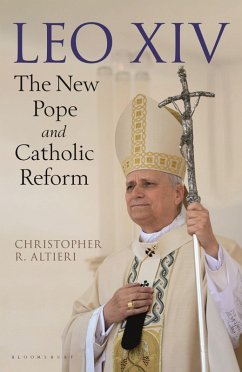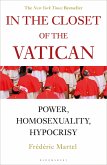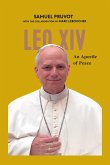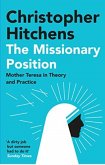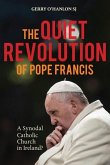- Gebundenes Buch
- Merkliste
- Auf die Merkliste
- Bewerten Bewerten
- Teilen
- Produkt teilen
- Produkterinnerung
- Produkterinnerung
Expert analysis from a veteran Vatican watcher on who the new American Pope few expected really is â and what his legacy within the Catholic Church might become.
Andere Kunden interessierten sich auch für
![In the Closet of the Vatican In the Closet of the Vatican]() Frederic MartelIn the Closet of the Vatican12,99 €
Frederic MartelIn the Closet of the Vatican12,99 €![Pope Leo XIV Pope Leo XIV]() Samual PruvotPope Leo XIV19,99 €
Samual PruvotPope Leo XIV19,99 €![Hildegard of Bingen Hildegard of Bingen]() Fiona Maddocks (Classical Music Critic - Observer)Hildegard of Bingen11,99 €
Fiona Maddocks (Classical Music Critic - Observer)Hildegard of Bingen11,99 €![The Missionary Position The Missionary Position]() Christopher HitchensThe Missionary Position8,49 €
Christopher HitchensThe Missionary Position8,49 €![Pope Leo XIV: Inside the Conclave and the Dawn of a New Papacy Pope Leo XIV: Inside the Conclave and the Dawn of a New Papacy]() Christopher WhitePope Leo XIV: Inside the Conclave and the Dawn of a New Papacy16,99 €
Christopher WhitePope Leo XIV: Inside the Conclave and the Dawn of a New Papacy16,99 €![Jesus Wept Jesus Wept]() Philip ShenonJesus Wept36,99 €
Philip ShenonJesus Wept36,99 €![The Quiet Revolution of Pope Francis The Quiet Revolution of Pope Francis]() Gerry O'Hanlon SJThe Quiet Revolution of Pope Francis19,99 €
Gerry O'Hanlon SJThe Quiet Revolution of Pope Francis19,99 €-
-
-
Expert analysis from a veteran Vatican watcher on who the new American Pope few expected really is â and what his legacy within the Catholic Church might become.
Produktdetails
- Produktdetails
- Verlag: Bloomsbury Publishing PLC
- Seitenzahl: 224
- Erscheinungstermin: 7. Oktober 2025
- Englisch
- Abmessung: 236mm x 155mm x 28mm
- Gewicht: 434g
- ISBN-13: 9781399430890
- ISBN-10: 1399430890
- Artikelnr.: 74966980
- Herstellerkennzeichnung
- Libri GmbH
- Europaallee 1
- 36244 Bad Hersfeld
- gpsr@libri.de
- Verlag: Bloomsbury Publishing PLC
- Seitenzahl: 224
- Erscheinungstermin: 7. Oktober 2025
- Englisch
- Abmessung: 236mm x 155mm x 28mm
- Gewicht: 434g
- ISBN-13: 9781399430890
- ISBN-10: 1399430890
- Artikelnr.: 74966980
- Herstellerkennzeichnung
- Libri GmbH
- Europaallee 1
- 36244 Bad Hersfeld
- gpsr@libri.de
Christopher R. Altieri holds a PhD (research doctorate in philosophy) from the Pontifical Gregorian University, and was Executive Editor of the Catholic Herald. He has nearly two decades' experience in journalism. An expert on the Vatican, Altieri is an accomplished investigator who has broken and reported major stories on a host of issues related to Church governance. His books include How To Read the News without Losing Your Faith (2021, CTS) and Into the Storm: Chronicle of a Year in Crisis (2020, TAN Books).
Preface and acknowledgments
Chapter 1: A radical choice
Profile of a pope
Pope Leo: What happened?
The Challenge of Reform
What reform looks like
No "Golden Age"
Chapter 2: A restless heart
(Extra)ordinary beginnings
Cerca y personal: Augustinian, missionary, prior
Prior general, bishop, cardinal
The hand of providence
Chapter 3: "Peace be with all of you."
Radically moderate
The power-and limits-of gestures and signs
Strange bedfellows: The College of Cardinals in brief
The conclave of May 2025 in context
Vicar of Christ: The man and the office
Chapter 4: An Augustinian pope
Power and order in the Augustinian mind
One commonwealth of all Christians: In illo uno unum
Journeying together
Pope Leo XIV: Two keys to understanding
Human nature and power in society: an Augustinian view
Citizen and stranger
Augustinian optimism
Chapter 5: A Lion of springtime
Technological eclipse
Worse (and also better)
Attention deficit
How the Church communicates
Leo XIV and the "culture of encounter"
From the personal to the institutional - continuities and discontinuities
Interlude: The State of the Vatican (and the state of the Church)
Reform "on the go"
Teaching and governance: Fernández in the DDF
In form for action(?): The Church on the international stage
The Church's shifting centre of gravity
Things come to a head: Fiducia supplicans
Unsustainable: Vatican finances in crisis
Looking forward: The papal in-tray
Chapter 6: Communications, curial culture, Synodality
The challenge of reform: Vatican Communications
Communication as listening: "Synodality" and the Synod of Bishops
Romanitas
Institutional memory
In short
Chapter 7: Financial reform
Misconceptions
Peter's Pence: Myth, facts, conjecture
Signs of the times
A threefold challenge for Pope Leo XIV
A long time coming
The bottom line
Chapter 8: Reform of justice
Leo XIV: Unfinished business
Justice in a fallen world
Practical challenges: Justice as closeness to victims
The requirements of natural justice
Natural justice and judicial independence
Reserve powers
The conciliarist controversy and its aftermath
Chapter 9: The nature and limits of papal governing power
Governing power as such
Justice in the ecclesiastical system
Twin challenges: transparency and judicial independence
Secretly untenable
What could Pope Leo XIV do?
Preliminary indications: theory and practice
An investigative arm
A Matter for the Synod of Bishops?
Making the pallium mean something (again)
Conclusion: Drivers of crisis
Notes
Chapter 1: A radical choice
Profile of a pope
Pope Leo: What happened?
The Challenge of Reform
What reform looks like
No "Golden Age"
Chapter 2: A restless heart
(Extra)ordinary beginnings
Cerca y personal: Augustinian, missionary, prior
Prior general, bishop, cardinal
The hand of providence
Chapter 3: "Peace be with all of you."
Radically moderate
The power-and limits-of gestures and signs
Strange bedfellows: The College of Cardinals in brief
The conclave of May 2025 in context
Vicar of Christ: The man and the office
Chapter 4: An Augustinian pope
Power and order in the Augustinian mind
One commonwealth of all Christians: In illo uno unum
Journeying together
Pope Leo XIV: Two keys to understanding
Human nature and power in society: an Augustinian view
Citizen and stranger
Augustinian optimism
Chapter 5: A Lion of springtime
Technological eclipse
Worse (and also better)
Attention deficit
How the Church communicates
Leo XIV and the "culture of encounter"
From the personal to the institutional - continuities and discontinuities
Interlude: The State of the Vatican (and the state of the Church)
Reform "on the go"
Teaching and governance: Fernández in the DDF
In form for action(?): The Church on the international stage
The Church's shifting centre of gravity
Things come to a head: Fiducia supplicans
Unsustainable: Vatican finances in crisis
Looking forward: The papal in-tray
Chapter 6: Communications, curial culture, Synodality
The challenge of reform: Vatican Communications
Communication as listening: "Synodality" and the Synod of Bishops
Romanitas
Institutional memory
In short
Chapter 7: Financial reform
Misconceptions
Peter's Pence: Myth, facts, conjecture
Signs of the times
A threefold challenge for Pope Leo XIV
A long time coming
The bottom line
Chapter 8: Reform of justice
Leo XIV: Unfinished business
Justice in a fallen world
Practical challenges: Justice as closeness to victims
The requirements of natural justice
Natural justice and judicial independence
Reserve powers
The conciliarist controversy and its aftermath
Chapter 9: The nature and limits of papal governing power
Governing power as such
Justice in the ecclesiastical system
Twin challenges: transparency and judicial independence
Secretly untenable
What could Pope Leo XIV do?
Preliminary indications: theory and practice
An investigative arm
A Matter for the Synod of Bishops?
Making the pallium mean something (again)
Conclusion: Drivers of crisis
Notes
Preface and acknowledgments
Chapter 1: A radical choice
Profile of a pope
Pope Leo: What happened?
The Challenge of Reform
What reform looks like
No "Golden Age"
Chapter 2: A restless heart
(Extra)ordinary beginnings
Cerca y personal: Augustinian, missionary, prior
Prior general, bishop, cardinal
The hand of providence
Chapter 3: "Peace be with all of you."
Radically moderate
The power-and limits-of gestures and signs
Strange bedfellows: The College of Cardinals in brief
The conclave of May 2025 in context
Vicar of Christ: The man and the office
Chapter 4: An Augustinian pope
Power and order in the Augustinian mind
One commonwealth of all Christians: In illo uno unum
Journeying together
Pope Leo XIV: Two keys to understanding
Human nature and power in society: an Augustinian view
Citizen and stranger
Augustinian optimism
Chapter 5: A Lion of springtime
Technological eclipse
Worse (and also better)
Attention deficit
How the Church communicates
Leo XIV and the "culture of encounter"
From the personal to the institutional - continuities and discontinuities
Interlude: The State of the Vatican (and the state of the Church)
Reform "on the go"
Teaching and governance: Fernández in the DDF
In form for action(?): The Church on the international stage
The Church's shifting centre of gravity
Things come to a head: Fiducia supplicans
Unsustainable: Vatican finances in crisis
Looking forward: The papal in-tray
Chapter 6: Communications, curial culture, Synodality
The challenge of reform: Vatican Communications
Communication as listening: "Synodality" and the Synod of Bishops
Romanitas
Institutional memory
In short
Chapter 7: Financial reform
Misconceptions
Peter's Pence: Myth, facts, conjecture
Signs of the times
A threefold challenge for Pope Leo XIV
A long time coming
The bottom line
Chapter 8: Reform of justice
Leo XIV: Unfinished business
Justice in a fallen world
Practical challenges: Justice as closeness to victims
The requirements of natural justice
Natural justice and judicial independence
Reserve powers
The conciliarist controversy and its aftermath
Chapter 9: The nature and limits of papal governing power
Governing power as such
Justice in the ecclesiastical system
Twin challenges: transparency and judicial independence
Secretly untenable
What could Pope Leo XIV do?
Preliminary indications: theory and practice
An investigative arm
A Matter for the Synod of Bishops?
Making the pallium mean something (again)
Conclusion: Drivers of crisis
Notes
Chapter 1: A radical choice
Profile of a pope
Pope Leo: What happened?
The Challenge of Reform
What reform looks like
No "Golden Age"
Chapter 2: A restless heart
(Extra)ordinary beginnings
Cerca y personal: Augustinian, missionary, prior
Prior general, bishop, cardinal
The hand of providence
Chapter 3: "Peace be with all of you."
Radically moderate
The power-and limits-of gestures and signs
Strange bedfellows: The College of Cardinals in brief
The conclave of May 2025 in context
Vicar of Christ: The man and the office
Chapter 4: An Augustinian pope
Power and order in the Augustinian mind
One commonwealth of all Christians: In illo uno unum
Journeying together
Pope Leo XIV: Two keys to understanding
Human nature and power in society: an Augustinian view
Citizen and stranger
Augustinian optimism
Chapter 5: A Lion of springtime
Technological eclipse
Worse (and also better)
Attention deficit
How the Church communicates
Leo XIV and the "culture of encounter"
From the personal to the institutional - continuities and discontinuities
Interlude: The State of the Vatican (and the state of the Church)
Reform "on the go"
Teaching and governance: Fernández in the DDF
In form for action(?): The Church on the international stage
The Church's shifting centre of gravity
Things come to a head: Fiducia supplicans
Unsustainable: Vatican finances in crisis
Looking forward: The papal in-tray
Chapter 6: Communications, curial culture, Synodality
The challenge of reform: Vatican Communications
Communication as listening: "Synodality" and the Synod of Bishops
Romanitas
Institutional memory
In short
Chapter 7: Financial reform
Misconceptions
Peter's Pence: Myth, facts, conjecture
Signs of the times
A threefold challenge for Pope Leo XIV
A long time coming
The bottom line
Chapter 8: Reform of justice
Leo XIV: Unfinished business
Justice in a fallen world
Practical challenges: Justice as closeness to victims
The requirements of natural justice
Natural justice and judicial independence
Reserve powers
The conciliarist controversy and its aftermath
Chapter 9: The nature and limits of papal governing power
Governing power as such
Justice in the ecclesiastical system
Twin challenges: transparency and judicial independence
Secretly untenable
What could Pope Leo XIV do?
Preliminary indications: theory and practice
An investigative arm
A Matter for the Synod of Bishops?
Making the pallium mean something (again)
Conclusion: Drivers of crisis
Notes
Preface and acknowledgments
Chapter 1: A radical choice
Profile of a pope
Pope Leo: What happened?
The Challenge of Reform
What reform looks like
No "Golden Age"
Chapter 2: A restless heart
(Extra)ordinary beginnings
Cerca y personal: Augustinian, missionary, prior
Prior general, bishop, cardinal
The hand of providence
Chapter 3: "Peace be with all of you."
Radically moderate
The power-and limits-of gestures and signs
Strange bedfellows: The College of Cardinals in brief
The conclave of May 2025 in context
Vicar of Christ: The man and the office
Chapter 4: An Augustinian pope
Power and order in the Augustinian mind
One commonwealth of all Christians: In illo uno unum
Journeying together
Pope Leo XIV: Two keys to understanding
Human nature and power in society: an Augustinian view
Citizen and stranger
Augustinian optimism
Chapter 5: A Lion of springtime
Technological eclipse
Worse (and also better)
Attention deficit
How the Church communicates
Leo XIV and the "culture of encounter"
From the personal to the institutional - continuities and discontinuities
Interlude: The State of the Vatican (and the state of the Church)
Reform "on the go"
Teaching and governance: Fernández in the DDF
In form for action(?): The Church on the international stage
The Church's shifting centre of gravity
Things come to a head: Fiducia supplicans
Unsustainable: Vatican finances in crisis
Looking forward: The papal in-tray
Chapter 6: Communications, curial culture, Synodality
The challenge of reform: Vatican Communications
Communication as listening: "Synodality" and the Synod of Bishops
Romanitas
Institutional memory
In short
Chapter 7: Financial reform
Misconceptions
Peter's Pence: Myth, facts, conjecture
Signs of the times
A threefold challenge for Pope Leo XIV
A long time coming
The bottom line
Chapter 8: Reform of justice
Leo XIV: Unfinished business
Justice in a fallen world
Practical challenges: Justice as closeness to victims
The requirements of natural justice
Natural justice and judicial independence
Reserve powers
The conciliarist controversy and its aftermath
Chapter 9: The nature and limits of papal governing power
Governing power as such
Justice in the ecclesiastical system
Twin challenges: transparency and judicial independence
Secretly untenable
What could Pope Leo XIV do?
Preliminary indications: theory and practice
An investigative arm
A Matter for the Synod of Bishops?
Making the pallium mean something (again)
Conclusion: Drivers of crisis
Notes
Chapter 1: A radical choice
Profile of a pope
Pope Leo: What happened?
The Challenge of Reform
What reform looks like
No "Golden Age"
Chapter 2: A restless heart
(Extra)ordinary beginnings
Cerca y personal: Augustinian, missionary, prior
Prior general, bishop, cardinal
The hand of providence
Chapter 3: "Peace be with all of you."
Radically moderate
The power-and limits-of gestures and signs
Strange bedfellows: The College of Cardinals in brief
The conclave of May 2025 in context
Vicar of Christ: The man and the office
Chapter 4: An Augustinian pope
Power and order in the Augustinian mind
One commonwealth of all Christians: In illo uno unum
Journeying together
Pope Leo XIV: Two keys to understanding
Human nature and power in society: an Augustinian view
Citizen and stranger
Augustinian optimism
Chapter 5: A Lion of springtime
Technological eclipse
Worse (and also better)
Attention deficit
How the Church communicates
Leo XIV and the "culture of encounter"
From the personal to the institutional - continuities and discontinuities
Interlude: The State of the Vatican (and the state of the Church)
Reform "on the go"
Teaching and governance: Fernández in the DDF
In form for action(?): The Church on the international stage
The Church's shifting centre of gravity
Things come to a head: Fiducia supplicans
Unsustainable: Vatican finances in crisis
Looking forward: The papal in-tray
Chapter 6: Communications, curial culture, Synodality
The challenge of reform: Vatican Communications
Communication as listening: "Synodality" and the Synod of Bishops
Romanitas
Institutional memory
In short
Chapter 7: Financial reform
Misconceptions
Peter's Pence: Myth, facts, conjecture
Signs of the times
A threefold challenge for Pope Leo XIV
A long time coming
The bottom line
Chapter 8: Reform of justice
Leo XIV: Unfinished business
Justice in a fallen world
Practical challenges: Justice as closeness to victims
The requirements of natural justice
Natural justice and judicial independence
Reserve powers
The conciliarist controversy and its aftermath
Chapter 9: The nature and limits of papal governing power
Governing power as such
Justice in the ecclesiastical system
Twin challenges: transparency and judicial independence
Secretly untenable
What could Pope Leo XIV do?
Preliminary indications: theory and practice
An investigative arm
A Matter for the Synod of Bishops?
Making the pallium mean something (again)
Conclusion: Drivers of crisis
Notes
Preface and acknowledgments
Chapter 1: A radical choice
Profile of a pope
Pope Leo: What happened?
The Challenge of Reform
What reform looks like
No "Golden Age"
Chapter 2: A restless heart
(Extra)ordinary beginnings
Cerca y personal: Augustinian, missionary, prior
Prior general, bishop, cardinal
The hand of providence
Chapter 3: "Peace be with all of you."
Radically moderate
The power-and limits-of gestures and signs
Strange bedfellows: The College of Cardinals in brief
The conclave of May 2025 in context
Vicar of Christ: The man and the office
Chapter 4: An Augustinian pope
Power and order in the Augustinian mind
One commonwealth of all Christians: In illo uno unum
Journeying together
Pope Leo XIV: Two keys to understanding
Human nature and power in society: an Augustinian view
Citizen and stranger
Augustinian optimism
Chapter 5: A Lion of springtime
Technological eclipse
Worse (and also better)
Attention deficit
How the Church communicates
Leo XIV and the "culture of encounter"
From the personal to the institutional - continuities and discontinuities
Interlude: The State of the Vatican (and the state of the Church)
Reform "on the go"
Teaching and governance: Fernández in the DDF
In form for action(?): The Church on the international stage
The Church's shifting centre of gravity
Things come to a head: Fiducia supplicans
Unsustainable: Vatican finances in crisis
Looking forward: The papal in-tray
Chapter 6: Communications, curial culture, Synodality
The challenge of reform: Vatican Communications
Communication as listening: "Synodality" and the Synod of Bishops
Romanitas
Institutional memory
In short
Chapter 7: Financial reform
Misconceptions
Peter's Pence: Myth, facts, conjecture
Signs of the times
A threefold challenge for Pope Leo XIV
A long time coming
The bottom line
Chapter 8: Reform of justice
Leo XIV: Unfinished business
Justice in a fallen world
Practical challenges: Justice as closeness to victims
The requirements of natural justice
Natural justice and judicial independence
Reserve powers
The conciliarist controversy and its aftermath
Chapter 9: The nature and limits of papal governing power
Governing power as such
Justice in the ecclesiastical system
Twin challenges: transparency and judicial independence
Secretly untenable
What could Pope Leo XIV do?
Preliminary indications: theory and practice
An investigative arm
A Matter for the Synod of Bishops?
Making the pallium mean something (again)
Conclusion: Drivers of crisis
Notes
Chapter 1: A radical choice
Profile of a pope
Pope Leo: What happened?
The Challenge of Reform
What reform looks like
No "Golden Age"
Chapter 2: A restless heart
(Extra)ordinary beginnings
Cerca y personal: Augustinian, missionary, prior
Prior general, bishop, cardinal
The hand of providence
Chapter 3: "Peace be with all of you."
Radically moderate
The power-and limits-of gestures and signs
Strange bedfellows: The College of Cardinals in brief
The conclave of May 2025 in context
Vicar of Christ: The man and the office
Chapter 4: An Augustinian pope
Power and order in the Augustinian mind
One commonwealth of all Christians: In illo uno unum
Journeying together
Pope Leo XIV: Two keys to understanding
Human nature and power in society: an Augustinian view
Citizen and stranger
Augustinian optimism
Chapter 5: A Lion of springtime
Technological eclipse
Worse (and also better)
Attention deficit
How the Church communicates
Leo XIV and the "culture of encounter"
From the personal to the institutional - continuities and discontinuities
Interlude: The State of the Vatican (and the state of the Church)
Reform "on the go"
Teaching and governance: Fernández in the DDF
In form for action(?): The Church on the international stage
The Church's shifting centre of gravity
Things come to a head: Fiducia supplicans
Unsustainable: Vatican finances in crisis
Looking forward: The papal in-tray
Chapter 6: Communications, curial culture, Synodality
The challenge of reform: Vatican Communications
Communication as listening: "Synodality" and the Synod of Bishops
Romanitas
Institutional memory
In short
Chapter 7: Financial reform
Misconceptions
Peter's Pence: Myth, facts, conjecture
Signs of the times
A threefold challenge for Pope Leo XIV
A long time coming
The bottom line
Chapter 8: Reform of justice
Leo XIV: Unfinished business
Justice in a fallen world
Practical challenges: Justice as closeness to victims
The requirements of natural justice
Natural justice and judicial independence
Reserve powers
The conciliarist controversy and its aftermath
Chapter 9: The nature and limits of papal governing power
Governing power as such
Justice in the ecclesiastical system
Twin challenges: transparency and judicial independence
Secretly untenable
What could Pope Leo XIV do?
Preliminary indications: theory and practice
An investigative arm
A Matter for the Synod of Bishops?
Making the pallium mean something (again)
Conclusion: Drivers of crisis
Notes
Chris Altieri is a provocative and passionate writer, with views forged by decades of experience and a deeply original intelligence. He's never been better than he is here, as he plumbs the early promise of the papacy of Leo XIV, from the tri-cultural character of the new pope's formation to his roots in a distinctly Augustinian spirituality. While it's all compelling, read Alteri especially on the looming challenges of institutional reform – which, as ever, is where the rubber truly meets the road. This is essential reading, not only on the pope but on the church in our times.

